Oh, Canada! The land of maple syrup, moose, and hockey. Did you know it’s also home to a litany of dangerous insects and spiders? While adventuring in Alberta or camping in British Columbia, keep an eye out for certain creepy-crawlies whose venom just might leave you in the hospital.
Discover the different types of animals that live in Canada and 10 of the most dangerous insects you’ll want to avoid on your next trip North.
What Types of Animals Live in Canada?

Canada’s expansive land is home to many animals and insects that pose dangers to people, pets, and the environment.
©Light and Vision/Shutterstock.com
Canada offers several types of climates in which many animals and insects make their homes. Much of the country has cool or temperate continental climates while the most northern parts of Canada boast cold enough temperatures and sparse vegetation to be considered a tundra.
Canada’s most-known animal in the country is also its most dangerous: the moose. In Canada’s forests and oceans you’ll also find animals like:
- Beavers.
- Bighorn Sheep.
- Wolverines.
- Beluga whales.
- Canadian geese.
This list barely scratches the surface of the many different animals one can encounter in Canada. However, when traveling, hiking, or adventuring in Canada, there are several insects you’ll want to watch out for based on the danger they pose to humans and the environment.
Here are the most dangerous insects in Canada.
The 10 Most Dangerous Insects in Canada
Can insects in Canada kill you? Most likely, no. While bites or stings untreated can complicate into larger health issues, these dangerous insects probably won’t inflict fatal damage.
#1. Brown Recluse Spider

Even though it has dangerous venom, the brown recluse has small fangs compared to most spiders.
©Physics_joe/Shutterstock.com
First on the list of the most dangerous insects in Canada, the brown recluse spider epitomizes the saying “small but mighty.” At only a half inch in length, brown recluse spiders can be incredibly hard to spot — which makes bites from their necrotic venom that much more terrifying. Brown recluse spiders, or Loxosceles reclusa, live an average of two to four years and are one of only three spiders in North America with significantly poisonous venom. Thankfully, the spiders are not outwardly aggressive and will only bite when they feel threatened or trapped.
While pest companies and entomologists debate the presence of brown recluse spiders in Canada, residents of British Columbia and southern Ontario report brown recluse bites. Alberta’s health department also informs its citizens about the dangers of brown recluse bites.
You can identify a brown recluse spider by its eyes, color, and shape. Instead of eight eyes, the brown recluse has six eyes; two groups of three on each side. It’s barely larger than a U.S. quarter and has a tannish/brown color with spiny legs.
What should you do if you’re bitten by a brown recluse spider? Ensure the spider is no longer on your body and cannot inflict more wounds, and then immediately seek medical attention. Brown recluse venom has necrotic capabilities. An ulcer or open sore can develop at the site of the bite without proper medical attention and treatment. While waiting for a physician to treat you, cool the area of the bite, avoid itching, and take a picture of the spider (or even capture it) so a medical professional can correctly treat you.
#2. Africanized Honey Bees
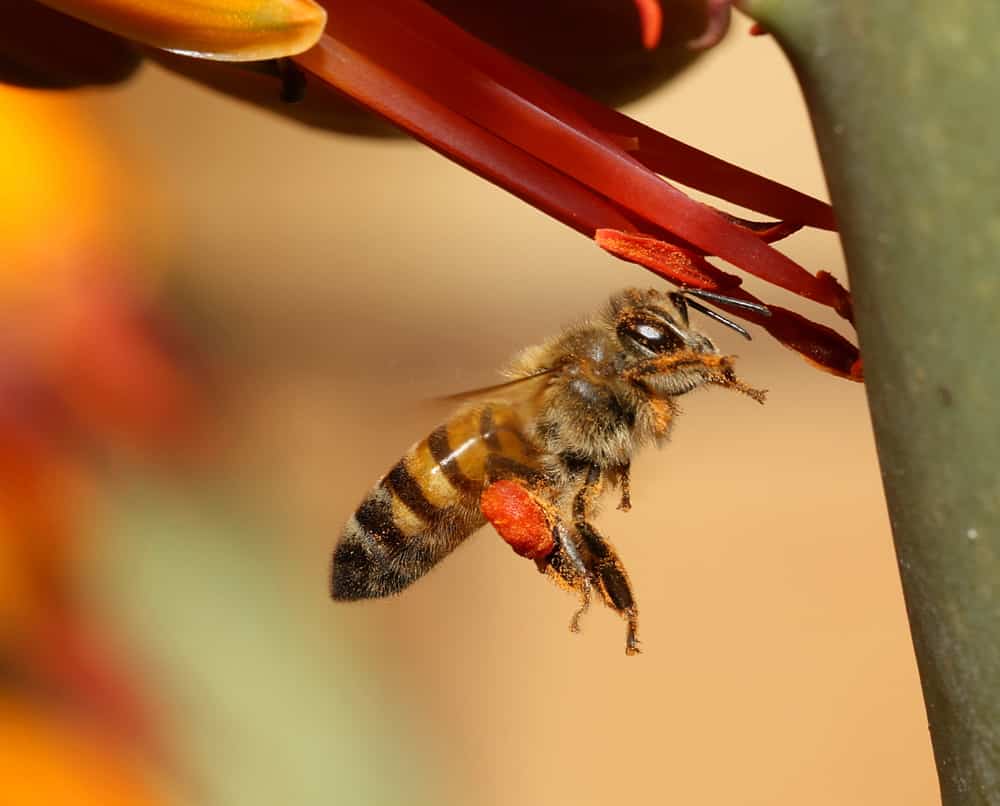
While one isn’t dangerous, a group or hive of these bees can inflict serious damage on a human or pet.
©Hennie Briedenhann/Shutterstock.com
Also known as “Killer bees,” the Africanized honey bee is an invasive species to Canada and North America in general. While they continue to move into northern territory, experts and studies show that they do not fare well in colder temperatures. The Apis mellifera scutellata might not swarm you in the Yukon, Northern Territories, or Nunavut, but you might see them in or around Vancouver and Toronto.
Africanized honey bees received their epithet based on behavior: they’re an aggressive species of bee known to attack in large numbers. These attacks can (and have) led to massive stinging incidents, which makes the bee stings so dangerous. One sting from a single Africanized honey bee isn’t fatal, but the amount of venom injected into a human body during a large-scale stinging attack may be enough to cause death.
What should you do if you’re stung by an Africanized honey bee? Because these bees have barbed stingers, get the stinger out of the wound first to halt the injection of venom. If you have multiple stings, be sure to unlodge each stinger before further treatment. Clean the area with soap and cold water, and then use a cold compress to combat the inflammation after removing the stinger. Over-the-counter, nonsteroidal medicines can curb the pain, itching, and swelling. It’s not necessary to visit a doctor after one or two stings, but if you’re the victim of a large-scale stinging attack, it’s a good idea to seek medical attention.
#3. Black Widow Spider
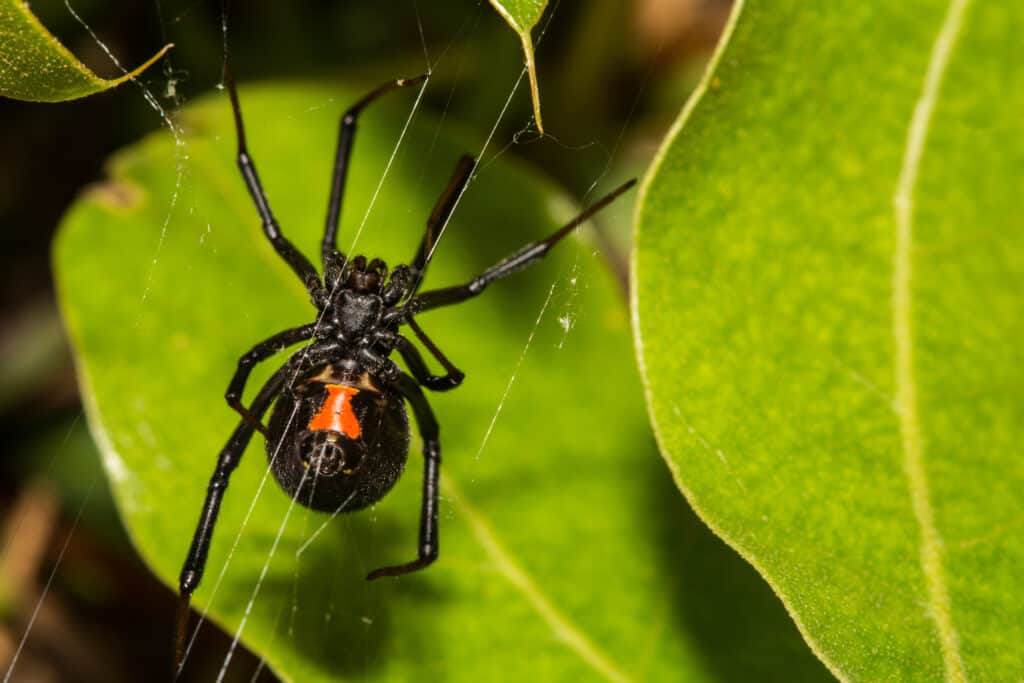
Black widow spiders have powerful venom.
©Jay Ondreicka/Shutterstock.com
Widely feared by populations where the spider is indigenous and invasive, the black widow Spider’s bite has the capability of stiffening muscles to the point you can’t walk. Though the bite is considered to be 15 times more poisonous than rattlesnake bites, most black widow bites aren’t lethal to healthy adults. However, seniors and young children are especially susceptible to complications from black widow venom and should see a doctor as soon as the bite is noticed.
Black widows aren’t an aggressive spider that seeks out humans. Instead, they prefer dark, dank corners (like garages). It’s imperative to call an exterminator if you find a black widow spider in your home, as it may have made a nest of 50 to 100 eggs. Black widows have frequented Toronto and Ontario homes.
Other symptoms of a black widow spider bite include nausea, swollen eyelids, itching, high blood pressure, and chest pain — among others. Black widow spiders are tiny like brown recluses, at just around a half inch in length.
What should you do if you’re bitten by a black widow spider? Though they’re the most venomous spiders in North America, one black widow bite isn’t fatal. If a black widow bites you, wash the bite site, apply some antibiotic cream, and hold an ice pack to the affected area. It’s probably a good idea to go to the emergency room in case your body has an adverse reaction to the venom.
#4. Mosquitos
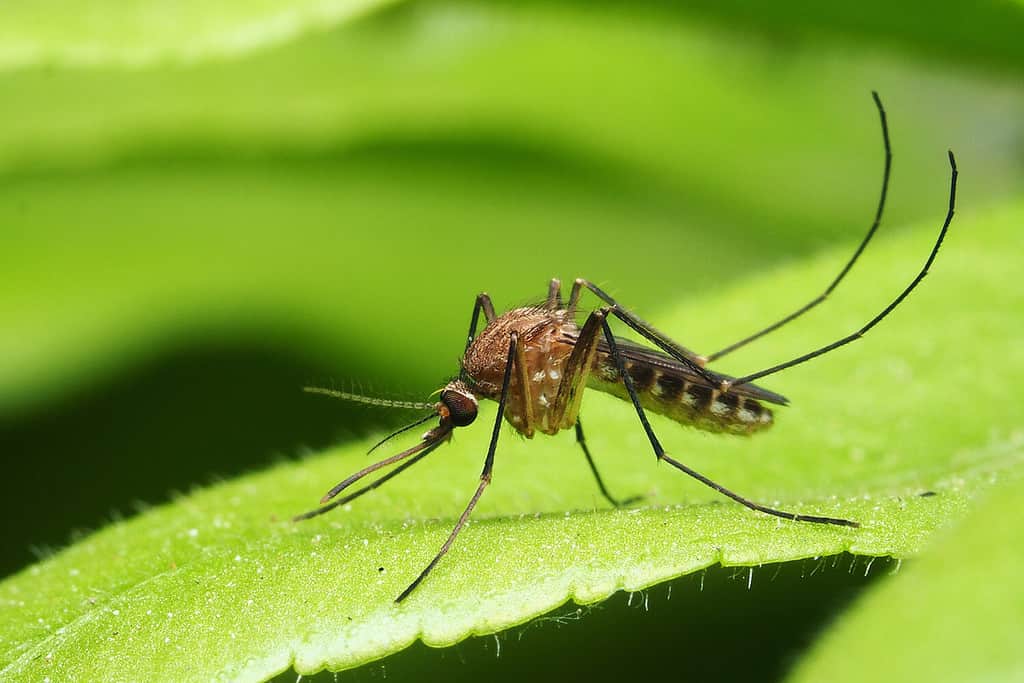
Mosquitos rank among Canada’s most dangerous insects.
©jiade/Shutterstock.com
Just because Canada is cold doesn’t mean mosquitos steer clear of the Great White North. In fact, Canada has three types of mosquitoes (Anopheles, Culex, and Aedes) that its residents and tourists must contend with.
The Aedes species carries the most variety of diseases, including (but not limited to):
- Dog heartworm.
- Yellow fever.
- West Nile virus.
- Zika virus.
- Dengue.
Anopheles, as it does everywhere it appears, carries malaria, and Culex carries encephalitis.
Each of these types of mosquitoes makes their home somewhere different in Canada. Anopheles and Culex prefer water to reproduce in or near Nova Scotia, southern Ontario, Saskatchewan, New Brunswick, and Quebec. Conversely, Aedes often appear in Ontario and other northern regions, as they prefer colder temperatures.
What should you do if you’re stung by a mosquito in Canada? Treat the bite with soap and water, and then consider seeing a medical professional. It’s important to watch for other symptoms after the bite occurs to identify which species affected you.
#5. Asian Giant Hornet
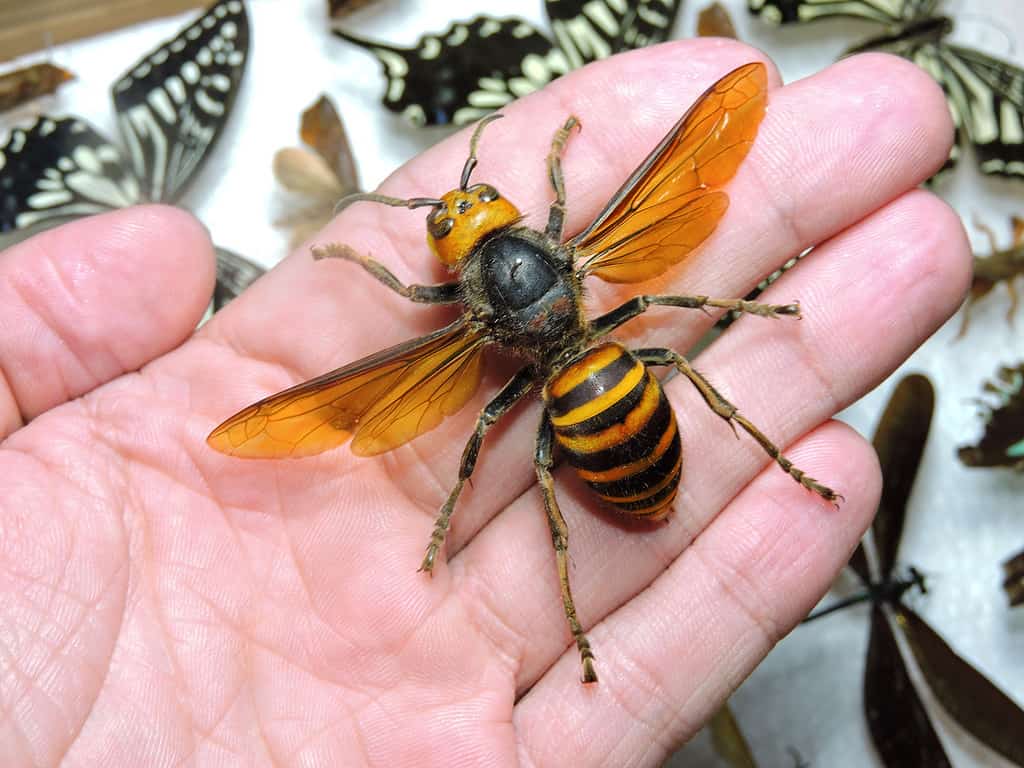
Asian giant hornets are massive compared to their cousins.
©iStock.com/Bruno Uehara
Not only does Canada have killer bees: poutine’s birthplace is also now home to invasive murder hornets. Asian giant hornets, also known as Vespa mandarinia, have a nasty way of keeping themselves and their hives protected. In addition to stinging, these hornets can also spit venom.
“Murder hornets” got their nickname from a similar reason as their cousins, the killer bees. Asian giant hornets are an aggressive species that will attack in large groups and sting their victim with as much venom as a snake. These hornets are the largest on Earth at 2.5 to five centimeters big.
When British Columbians found the first Asian giant hornet nest in 2019, the nest was destroyed to halt the spread of the species. Still, the threat of these hornets remains in Canada and agencies request that residents don’t attempt to kill or take out a hive on their own. Instead, it’s best to photograph and report the existence and leave the job to the professionals.
What should you do if you’re stung by an Asian giant hornet? Treat the sting like you would other bee stings: wash the site with soap and water, and then apply a cold compress or ice pack to slow the release and spread of venom. Seek medical attention immediately if you’re allergic to bee stings, start to feel dizzy, or lose feeling in any extremity.
#6. Ticks
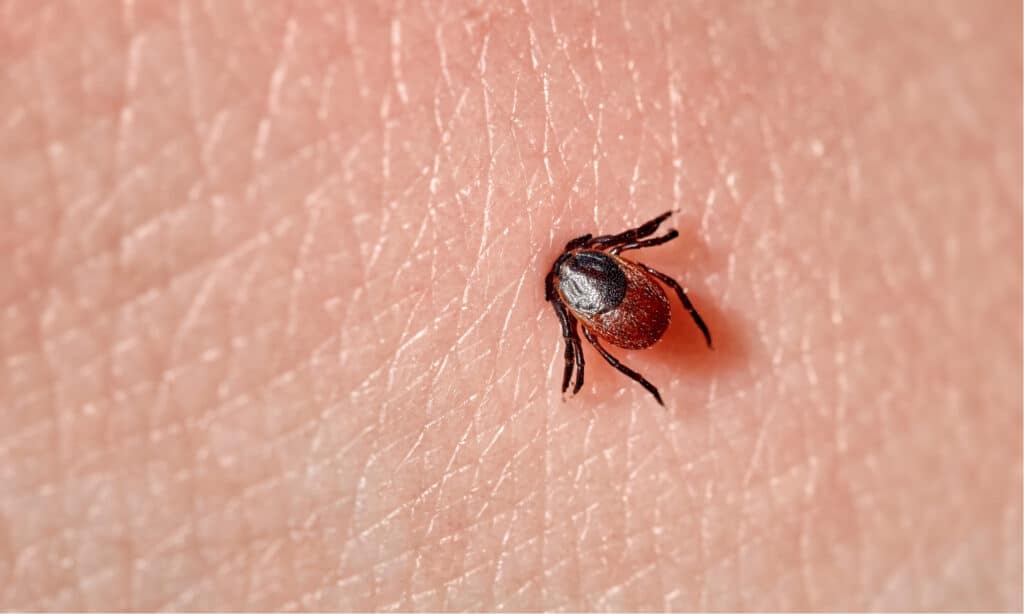
Deer ticks can survive in the winter and burrow into the skin to suck blood.
©Evgeniyqw/Shutterstock.com
Ticks live across the world — but four species commonly call Canada home. “Tick season” occurs in the spring and summer months, when nymphs are maturing, and in the fall, when the adult ticks become a problem. As vectors of disease, it’s important to take precautions outside to avoid tick bites.
Watch out for these species of ticks in Canada when outside:
- Deer tick. These bites often result in itching and a bullseye-like rash around the bite site. Deer ticks often carry Lyme disease, but not always. The tick must be on you for 36 to 48 hours to fully transfer the disease to you.
- Brown dog tick. Adequately named, the brown dog tick tends to carry canine diseases like ehrlichiosis and babesiosis that can infect and deteriorate a dog’s health. These ticks often choose dogs over humans, but ticks on a dog with a severe infestation may jump to a nearby human.
- American dog tick. This species carries dangerous diseases including tularemia and Rocky Mountain spotted fever. Their bite symptoms range from mild fever and rashes to tick paralysis.
- Rocky Mountain wood tick. These ticks will latch onto humans, dogs, and cats and have the ability to transmit Colorado tick fever virus, as well as tularemia and Rocky Mountain spotted fever. Their bright red, tear-shaped body is a great way to identify the species.
What should you do if you’re bitten by a tick in Canada? Make sure you remove the tick before anything else. If you can, keep the tick in a glass bottle, so you can share it with a medical professional. Wash the affected area with soap and water, apply antiseptic cream, and keep an eye on your symptoms.
#7. German Yellow Jackets

These wasps can give you a hypersensitivity to stings.
©tasnenad/Shutterstock.com
Yet another invasive bee in Canada is the German yellow jacket, or Vespula germanica, which are medium-sized wasps with a sting and long-lasting effects. These yellow jackets aren’t as aggressive as the other bees on this list, but just as dangerous if a large quantity attacks one person at the same time.
When stung by a German yellow jacket, some people have severe allergic reactions. Others can develop a hypersensitivity that starts after the first sting. Every bee sting after the German yellow jacket’s first will cause significantly more pain than before. It may even elicit a severe allergic reaction.
What should you do if you’re stung by a German yellow jacket? First, take the stinger out of your skin. Be sure to clean the wound with soap and water. Then hold a cold compress or ice pack to it to slow the spread of venom, just as you’d do for a hornet or wasp sting.
#8. European Fire Ants
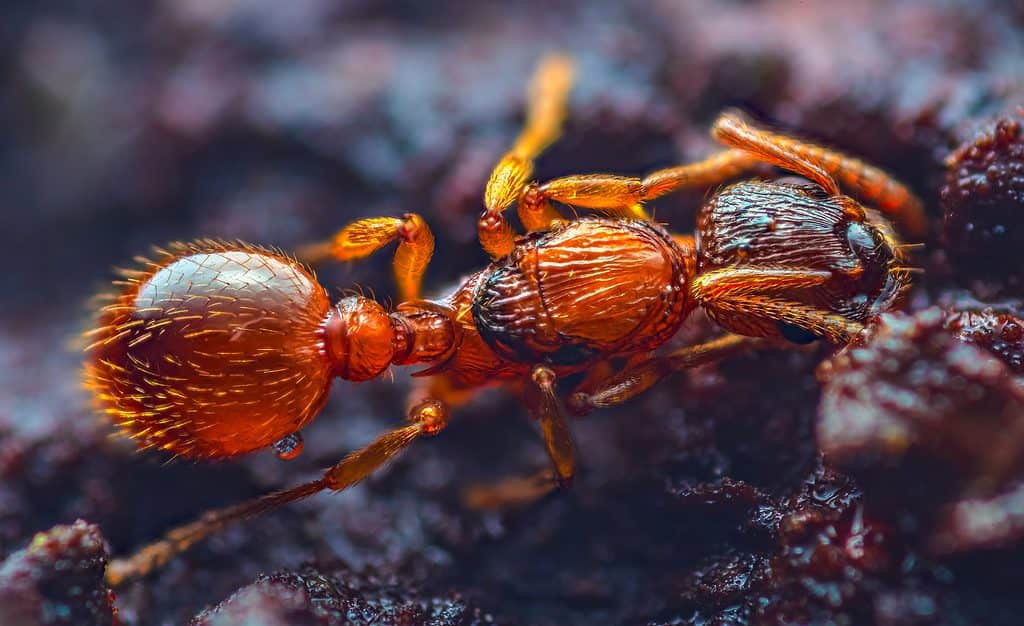
European Fire Ant bites create a pustule after a few hours.
©Lukas Jonaitis/Shutterstock.com
Like Africanized honey bees, European fire ants, also known as Myrmica rubra, prefer warmer climates but found their way to Canada.
Overall, these ants remain aggressive and will both bite and latch onto victims if threatened or approached. Bites won’t necessarily debilitate a human, but some may have a significant allergic reaction to the alkaloids in the ant’s venom. Most frighteningly, these ants do not fear humans and will attack if provoked.
What should you do if you’re bitten by a European fire ant? Fire ant bites result in a pustule, or blister that fills with pus and fluids a few hours to a day after a bite. If you know you’re not allergic to European fire ant venom, treat the bite as you would any other and leave it to scab. If you begin to feel dizzy, nauseous, or weak, seek medical attention immediately.
#9. Asian Longhorned Beetle

The Asian longhorn beetle is one of the most invasive beetle species in the world.
©Kurit afshen/Shutterstock.com
First on the list to endanger the environment rather than human health, the Asian longhorned beetle (Anoplophora glabripennis) poses a significant risk to Canada’s sprawling ecosystem. Only found in Ontario, this beetle focuses its efforts on maples as well as hardwoods like poplar, birch, and elm. Just a few of the negative effects of this beetle’s presence include:
- The loss of maple trees that impacts the thriving maple syrup industry.
- The eradication of Indigenous peoples’ cultural and spiritual connections to affected hardwood trees.
- A potential loss or reduction in recreation and tourism industries for Canadian “fall color” tours in the Ontario forests.
Asian longhorned beetles cause significant damage to trees by burrowing and chewing their way through trunks, leaving gaping holes and tunnels. Females lay their eggs in the trunks and feed on vegetation, thereby decimating an entire tree.
#10. Spruce Budworm
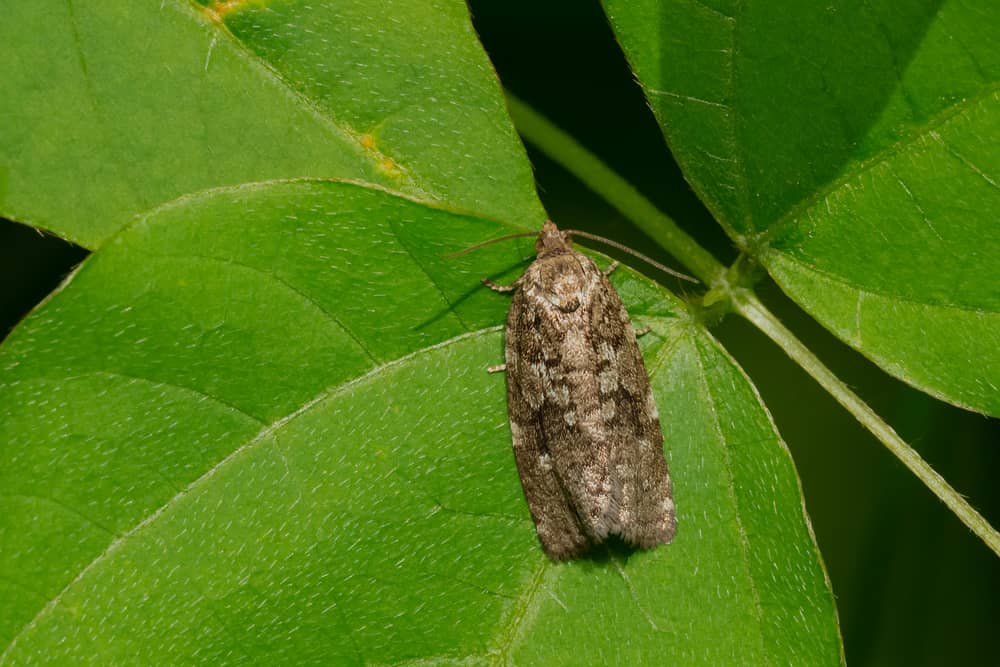
Spruce budworms are dangerous to Canada’s ecosystem and forests.
©Paul Reeves Photography/Shutterstock.com
This cyclical insect also poses major risks to the ecosystem and forests, making it the last on this list of dangerous insects in Canada.
The outbreak cycles of the spruce budworm (Choristoneura fumiferana) happen every 30 to 40 years and the outbreak can persist for several years after the first occurrence. The most recent outbreak, beginning in 2006, has seen significant deforestation at the hands of the spruce budworm. Experts estimate that in the years between 2006 and 2019, almost 10 hectares of Quebecian forests have suffered moderate to severe defoliation.
Defoliation has a massive negative effect on Canada’s forests. Not only does it eradicate much-needed ecosystems for animals; it results in a loss of timber — one of Canada’s major exports. Agencies in Canada have pest management systems in place but still struggle to control or eradicate outbreaks without disrupting the rest of the ecosystem.
Summary of the Top 10 Most Dangerous Insects in Canada
| Rank | Insect |
|---|---|
| #1 | Brown Recluse spider |
| #2 | Africanized Honeybee |
| #3 | Black Widow spider |
| #4 | Mosquitos |
| #5 | Asian Giant Hornet |
| #6 | Ticks |
| #7 | German Yellow Jackets |
| #8 | European Fire Ants |
| #9 | Asian Longhorned Beetle |
| #10 | Spruce Budworm |
Canada Is Full of Creepy Crawlies
A trip to Canada promises adventure, nature, and wonderful sights. As you explore, keep an eye out for these dangerous insects in Canada. Protect yourself with insect spray, long pants on hikes, and the proper treatment for the most dangerous bites and stings.
The photo featured at the top of this post is © Jay Ondreicka/Shutterstock.com
Thank you for reading! Have some feedback for us? Contact the AZ Animals editorial team.







